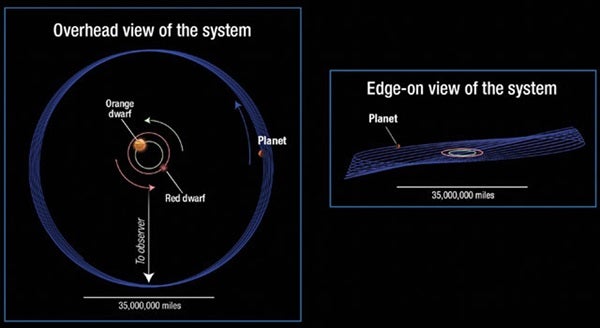The planet, designated Kepler-413b, is located 2,300 light-years away in the constellation Cygnus. It circles a close pair of orange and red dwarf stars every 66 days.
But what makes this planet unusual is that it wobbles, or precesses, wildly on its spin axis, much like a child’s top. The tilt of the spin axis of the planet can vary by as much as 30° over 11 years, leading to the rapid and erratic changes in seasons. Contrast this to Earth’s rotational precession: 23.5° over 26,000 years. The fact that this far-off planet is precessing on a human timescale is simply amazing.
Chances are you really wouldn’t be wondering what to wear on this planet because it’s a bit too warm for life as we know it. It orbits slightly closer to the stars than the inner edge of the system’s habitable zone, a region where temperatures allow for liquid water to exist. It’s also a gas giant planet of about 65 Earth masses — a super-Neptune — so there wouldn’t be any surface to stand on.
The planet’s orbit is unusual in that it is tilted 2.5° with respect to the plane of the binary star’s orbit. Over an 11-year period, the planet’s orbit also would appear to wobble as it circles around the star pair.
Astronomers using Kepler discovered this characteristic when they found an unusual pattern of transits for Kepler-413b. Normally, transiting planets are seen passing in front of their parent stars like clockwork. Kepler finds such planets by noticing the dimming of the parent star — or in this case, stars — as the planet travels in front of one of them.
“What we see in the Kepler data over 1,500 days is three transits in the first 180 days (one transit every 66 days), then we had 800 days with no transits at all,” said Veselin Kostov from the Space Telescope Science Institute (STScI) in Baltimore. “After that, we saw five more transits in a row.”
The next transit is not predicted to occur until 2020. This is due not only to the orbital wobble, but also to the small diameters of the stars and the fact that the orbital plane of the stars is not exactly edge-on to our line of sight. It just so happened that the astronomers caught the planet while it was transiting.
Because of the orbital wobble, the orbit continuously moves up or down relative to our view. This change is large enough that sometimes it misses passing in front of the stars, as seen from Earth.
To understand the complicated motions of this planet, imagine a bicycle wheel lying on its side. Spin the wheel while it is lying on the ground, and it will wobble. This is like the orbit of the planet. Now imagine putting a spinning top on the rim of the horizontal spinning wheel. This is like the wobbling motion of the planet’s rotational precession.
Astronomers are still trying to explain why this planet is out of alignment with its stars. There could be other planetary bodies in the system that tilted the orbit. Or, it could be that a third star nearby that is a visual companion may actually be gravitationally bound to the system and exerting an influence.
“Presumably there are planets out there like this one that we’re not seeing because we’re in the unfavorable period,” said Peter McCullough from STScI. “And that’s one of the things that Veselin is researching: Is there a silent majority of things that we’re not seeing?”










